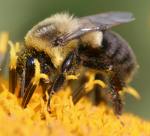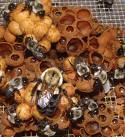
The fuzzy looking black and yellow bumblebees are the gentle giants of my garden and I enjoy them in the morning as I work among them and the plants. Once in a while I make the mistake of grabbing one of them when I pull out a weed they are visiting and I get a sharp reminder that I must be more careful but usually they go about their business around me. I am lucky that I have only a slight reaction to bumble stings because I know how terrible stings can be to others and I regret that they cannot enjoy these bees as I do.
Enjoyment of these wonderful bees is only one of the reasons for having them in the garden. They are excellent pollinators of many fruits and vegetables including raspberries, cranberries, peppers, squash, blueberries, and strawberries and actually are better than honeybees at pollinating tomatoes and eggplants. An individual bumblebee can carry more pollen than an honeybee but honeybees live in colonies of 10,000-30,000 bees while bumblebee colonies have only 50-500 bees so overall honeybees are considered more effective pollinators.

Bumblebees are like their close relatives the honeybees in several ways. Both are social insects that live in a colony with one egg laying queen and many workers that are the daughters of the queen. During mating season drones are produced. Both kinds of bees produce honey but bumblebees have much less and do not have flat vertical combs. Bumblebees can get to work earlier in the morning than most insects because they can shiver their flight muscles to keep warm but they have a shorter life span because all but the queen die in the cold months. In the spring the queen goes alone in search of a new site and usually finds one in a clump of grass or in a cavity in the ground made by another animal. A mouse nest is a favorite.
I want to encourage bumblebee colonies in my garden and so I try to avoid disturbing areas that might have nests. I also grow plants that attract them and provide the nectar they need. They are especially fond of purple, blue, and yellow flowers; some species have long tongues and need flowers with long tubes of petals like clovers, vetches, and thistles. In spring, rhododendrons, azaleas, willow, and beardstongue (Penstemon spp) bloom, while in summer, Salvia farinacea ‘Victoria’, Anise hyssop (Agastache foeniculum), bee balm (Monarda fistulosa), Joe-pye weed (Eupatorium maculatum), aster, and goldenrod (Solidago spp) do so. The dahlias and zinnias in my garden provide resting spots for bumblebees in late afternoon and evening after a hard day’s work.

Great post, Karen. I’ve had a lot of success attracting bees with peonies (pink, white and fuscia.) My rhodies ( a rich red) have a nice buzz about them. You got some good suggestions here. I’ll work on more dahlias, zinnias and azaleas per your advice.
Thanks for the motivation!
Hi Karen
great post, – i’m also trying my hardest to attract bumble bees, – here in Surrey, England, I was working next to a Lonicera Fragrantissima (winter flowering honeysuckle) last week, that was humming with bees, – so don’t forget plants at the beginning of the season
How lucky you are to have bees this time of year.
My husband and I have gone to England twice just to see gardens. W rented a house for a week at a time and visited 2-3 gardens in the nearby area every day. What a great garden heritage you have. We loved every minute of our visit.
I am thrilled to know that you see a value in Latin; it is losing ground here.
Karen
Thanks for your comments. It looks like you have a very good thing going with your lawn expertise. I will benefit immensely.
karen
I live in Wisconsin and was out in the vegetable garden yesterday and I was pleased to see bumble bees flying about between the yellow blossoms on the tomato and cucumber plants.
Chrissy,
The bumble bees are great company in the garden. I love watching their antics when they work away on the flowers and have only stung stung when I accidentally grabbed one when dead heading. Enjoy!
Apparently lavender is wonderful for attracting bumble bees, according to my friend so i am going to get some for the front garden today
There are many plants that bees love so be sure the plant blooms for a long time so you can enjoy them all season. Salvia ‘Victoria’ is the major bee magnet in my garden and blooms all summer (my lavender doesn’t).